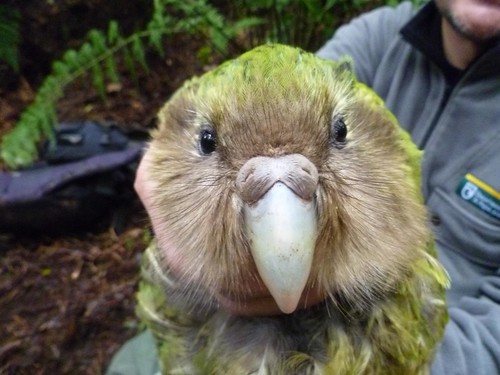 The death of Barnard the kakapo drops the kakapo population to 125 parrots. Courtesy the Kakapo Recovery Program.Kakapo Recovery has been dealt a disappointing blow, following the discovery of another dead bird – the sixth during the past year.
The death of Barnard the kakapo drops the kakapo population to 125 parrots. Courtesy the Kakapo Recovery Program.Kakapo Recovery has been dealt a disappointing blow, following the discovery of another dead bird – the sixth during the past year.
Barnard was found dead by kakapo rangers on Whenua Hou/Codfish Island at the weekend, when they went looking for him for his annual transmitter change.
Kakapo Recovery programme manager Deidre Vercoe Scott said the team was gutted by Barnard’s death, especially since it appeared to have gone unnoticed for up to three months.
 Program Barnard, pictured being checked by a member of the Kakapo Recovery Program, fathered eight chicks and helped boost the population. Courtesy the Kakapo Recovery “While it’s true we only sight these birds once a year for health checks and a transmitter change, Kakapo Recovery prides itself on having technology that allows us to monitor our precious population, with minimal interference.
Program Barnard, pictured being checked by a member of the Kakapo Recovery Program, fathered eight chicks and helped boost the population. Courtesy the Kakapo Recovery “While it’s true we only sight these birds once a year for health checks and a transmitter change, Kakapo Recovery prides itself on having technology that allows us to monitor our precious population, with minimal interference.
“But that technology is constantly changing to increase the information that we can collect. We may be experiencing some problems with how we interpret these complex transmitter signals accurately, so we will be looking into this closely. While it won’t prevent a kakapo death, identifying a mortality signal as soon as possible means we get better information from the autopsy examination.”
Barnard was an unknown-age bird, first discovered on Stewart Island in 1982. He fathered eight chicks, including five of the 11 hatched during the last breeding season in 2011. His death sees the kakapo population reduce to 125.
Ms Vercoe Scott said kakapo deaths were a reminder that, although Kakapo Recovery had achieved much during the past 22 years – increasing the total population from 49 to 131 last year – the kakapo was still a critically endangered species and vulnerable. And, with an ageing population, an increase in mortality was inevitable.
“We can expect to see the population numbers continue to go up and down for several years to come because quite a few of the birds are possibly very old. The good news is more than half the kakapo population consists of young breeding age birds and indications are that there will be a breeding season this summer - planning for that is well underway.”